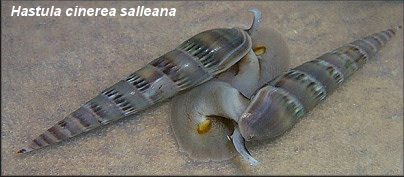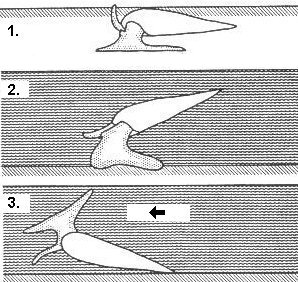Surf’s Up! |
|
By Bill Frank |
 During the spring and summer months the beaches here in northeast Florida will be alive with surfers - but not only of the human persuasion. Those other surfers are Hastula cinerea salleana (Deshayes, 1859) - a small (less than 50 mm.), slender, high-spired gastropod of the family Terebridae (commonly known as Augers). The species, which begins showing up in the surf here in northeast Florida as early as April, can be found from Georgia through the Gulf of Mexico to Nicaragua. Locally, the species is particularly popular with children who like nothing better than to effect a capture as these very active mollusks literally "surf" the breakers. Like other sand-burrowing snails, H. cinerea salleana has a large foot with which it ploughs through the sand. The foot of H. cinerea salleana is also used as a "sail" to enable the animal to move rapidly into deeper water when it is about to be stranded above the swash zone by a falling tide.
No one knows for sure as to what motivates H. cinerea salleana to leave the sand when the changing tide leaves it behind. One hypothesis is that the species, preferring a substrate frequently wetted, climbs out of the sand into the swash water whenever the intervals between inundations become too long. Since H. salleana have been observed mating in the surf, another possibility is that this behavior may related to location of partners. *Based on the report "Observations on the behavior of the littoral gastropod Terebra salleana," published in Ecology, Vol. 42, No.1, Jan., 1961. |
 As
the water recedes during a falling tide, the swash zone moves
seaward and the interval of time between successive inundations
of a previous swash zone becomes progressively longer. Specimens
of H. cinerea salleana
inhabiting an area being left behind by receding water
remain below the sand with only the tip of the siphon exposed (Fig.
1). Then, when a wave with more than normal force pushes swash
water over the area, each snail moves rapidly to the surface,
raises the apex of the shell in a jerking movement (Fig 2.) and,
forcefully throwing the apex to either the right or left in a
twisting motion, falls on its dorsal side with the foot facing
upward; the foot, held at about a 45 degree angle to the
longitudinal axis of the shell, now acts as a sail, and carries
the snail seaward with the outgoing swash (Fig. 3). With the foot
in this position, H. cinerea salleana can be
carried a considerable distance by slowly moving current.
As
the water recedes during a falling tide, the swash zone moves
seaward and the interval of time between successive inundations
of a previous swash zone becomes progressively longer. Specimens
of H. cinerea salleana
inhabiting an area being left behind by receding water
remain below the sand with only the tip of the siphon exposed (Fig.
1). Then, when a wave with more than normal force pushes swash
water over the area, each snail moves rapidly to the surface,
raises the apex of the shell in a jerking movement (Fig 2.) and,
forcefully throwing the apex to either the right or left in a
twisting motion, falls on its dorsal side with the foot facing
upward; the foot, held at about a 45 degree angle to the
longitudinal axis of the shell, now acts as a sail, and carries
the snail seaward with the outgoing swash (Fig. 3). With the foot
in this position, H. cinerea salleana can be
carried a considerable distance by slowly moving current.